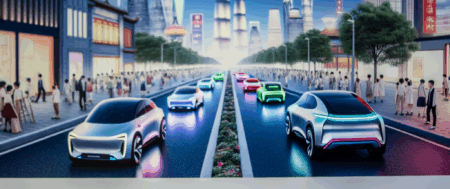In the race to dominate the Largest Automotive Market, both foreign automakers and domestic car brands are vying for the attention of China’s middle class amidst urbanization and a growing economy. The shift towards Electric Vehicles (EVs) and New Energy Vehicles (NEVs), driven by environmental concerns and Government Incentives, is spiking market competition. Strategies include navigating the complex regulatory landscape through Joint Ventures, leveraging local consumer preferences, and making technological advancements. Key players range from Tesla with its wholly-owned factories to domestic frontrunners like BYD and Nio. Strategic Partnerships between foreign and domestic companies are key in marrying global manufacturing prowess with deep local market insight. With the government’s pivotal role in promoting a greener automotive sector, success hinges on adapting to regulatory changes, understanding Consumer Preferences, and technological innovation.
In the fast-paced lanes of the global economy, the China automotive market stands as a colossus, reigning supreme as the world’s largest automotive market in both production and sales. This dominance is fueled by a rapidly growing economy, a burgeoning middle class, and an unyielding wave of urbanization, positioning China as a central hub in the global automotive arena. The market’s vibrancy is further accentuated by a robust demand for an array of car brands, both domestic and foreign, with a spotlight on Electric Vehicles (EVs) and New Energy Vehicles (NEVs). This surge is propelled by a combination of government incentives and mounting environmental concerns, highlighting a conscious shift towards greener transportation solutions.
Foreign automakers, in their quest to tap into this lucrative expanse, often find themselves navigating through China’s complex regulatory landscape via joint ventures and strategic partnerships with local entities. This not only unlocks the door to the vast consumer base but also serves as a testament to the dynamic and competitive nature of the market, influenced heavily by government policies, consumer preferences, technological advancements, and the ebb and flow of global economic trends.
As we delve into the multifaceted layers of China’s automotive sector, from the electrifying growth of EVs and NEVs to the strategic maneuvers behind joint ventures, and the driving forces of consumer demand to the pioneering innovations steering the industry forward, it becomes clear that understanding this market is no small feat. It requires a keen insight into local regulations, a pulse on shifting consumer behaviors, an eye for emerging market trends, and a flair for fostering strategic alliances. Join us as we explore the intricate roadways of China’s automotive landscape, where top domestic car brands and foreign automakers alike vie for supremacy in the largest automotive market under the guiding stars of government incentives, environmental consciousness, and a relentless pursuit of innovation.
1. “Navigating the Road Ahead: How Top Foreign and Domestic Brands are Competing in the World’s Largest Automotive Market”

In the race to dominate the world’s largest automotive market, both top foreign automakers and domestic car brands are deploying innovative strategies to capture the attention of China’s burgeoning middle class, whose appetite for automobiles has surged in tandem with the country’s rapidly growing economy and urbanization trends. This intense market competition is further fueled by a shift towards Electric Vehicles (EVs) and New Energy Vehicles (NEVs), propelled by environmental concerns and substantial government incentives aimed at reducing the country’s carbon footprint.
Foreign automakers have long eyed China’s vast consumer base, seeking to penetrate the market by forming joint ventures with local Chinese companies. This approach not only helps navigate the complex regulatory landscape but also taps into the domestic firms’ deep understanding of consumer preferences and market dynamics. Companies like Tesla have made significant inroads by establishing wholly-owned factories, marking a shift in how foreign entities can operate within the sector.
On the other side, domestic car brands are not standing idly by. Brands such as BYD and Nio are leveraging their home-ground advantage, pushing the envelope in technological advancements, and offering a range of EVs and NEVs that cater to the local market’s tastes and preferences. Their deep knowledge of the regulatory environment and consumer behavior gives them a competitive edge, enabling them to swiftly adapt to policy changes and market trends.
Strategic partnerships between foreign and domestic firms are increasingly common, aiming to combine international expertise in automobile manufacturing with local know-how of the Chinese market. These collaborations are vital for navigating the ever-evolving landscape, marked by rapid technological advancements and shifting regulatory policies.
The government’s role in shaping the market cannot be overstated. Through a mix of incentives for EV and NEV purchases and stringent regulations on traditional combustion vehicles, policymakers are steering the market towards a more sustainable and environmentally friendly direction. These efforts align with the global shift towards green transportation solutions, placing China at the forefront of the electric mobility revolution.
As the automotive industry continues to evolve, understanding and adapting to the regulatory landscape, consumer preferences, and technological advancements will be key for both foreign automakers and domestic car brands. The competition in China’s automotive market is a high-stakes game, with success requiring a blend of innovation, strategic partnerships, and a keen sense of the local market’s pulse. The road ahead is challenging, yet it offers immense opportunities for those able to navigate its complexities.
In conclusion, the journey through China’s vast and evolving automotive landscape reveals a market of unparalleled scale and opportunity. As the largest automotive market in the world, China presents a unique blend of challenges and rewards for both domestic car brands and foreign automakers alike. The competition is fierce, driven by a growing economy, rapid urbanization, and an expanding middle class with evolving consumer preferences. Electric Vehicles (EVs) and New Energy Vehicles (NEVs) are at the forefront of demand, spurred by environmental concerns and attractive government incentives. To navigate the complex regulatory landscape, strategic partnerships through joint ventures have become essential, allowing foreign brands to tap into the market’s full potential while adhering to local regulations.
The success in this dynamic market is not solely about understanding the current trends in technology and consumer behavior but also about anticipating future movements. Technological advancements continue to reshape the playing field, making adaptability and innovation key components for companies aiming to maintain or achieve market leadership. Moreover, the importance of aligning with government policies cannot be understated, as these will continue to influence the direction of the automotive industry, particularly in the areas of EVs and NEVs.
For companies willing to invest in understanding the regulatory landscape, consumer preferences, and the importance of joint ventures and strategic partnerships, the rewards can be significant. As the market continues to grow and evolve, the opportunities for both domestic and foreign brands will expand, offering a bright future for those able to navigate the complexities of the world’s largest automotive market. The path forward in China’s automotive sector is both exciting and challenging, requiring a deep commitment to innovation, local collaboration, and a keen eye on the rapidly changing market dynamics.






